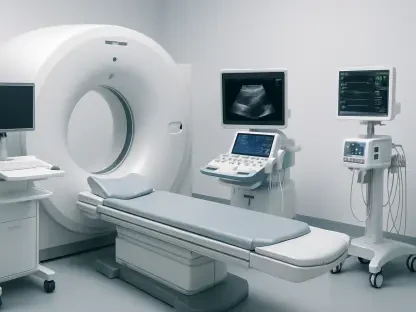The radiology sector is witnessing a dynamic transformation in revenue cycle management as technology and regulatory changes redefine financial operations. Artificial intelligence, once considered a futuristic tool, now plays a decisive role in reshaping how radiology practices navigate the complexities of billing and reimbursement. It not only enhances diagnostic accuracy and patient care, but also optimizes billing processes, making the financial management of radiology practices more efficient and profitable. Given this evolution, it is crucial for stakeholders such as CEOs, CFOs, and practice managers to remain informed about the current and emerging trends influenced by AI to maintain competitiveness and financial health.
The Economic Impact of Medicare Cuts and Reimbursement Declines
Medicare’s Payment Challenges
The economic stress on radiology practices is exacerbated by continual cuts in Medicare payments, creating significant financial challenges. In 2025, Medicare implemented a 2.8% cut to the conversion factor, intensifying the pressure on radiologists. Despite improvements in performance reflected in relative value units (RVUs), inflation-adjusted conversion factors have seen a drastic reduction of nearly 34% over the last two decades. Such cuts force radiology practices to achieve greater efficiency with diminishing resources, a daunting task that places heavy burdens on small and mid-sized practices heavily reliant on these reimbursements for financial stability.
These sweeping changes demand that radiology practices innovate or potentially face severe fiscal repercussions. Practices are compelled to scrutinize every aspect of their operations to enhance efficiency without sacrificing the quality of patient care. The decline in reimbursement rates fundamentally alters the financial landscape for radiologists, necessitating strategic adjustments and innovative solutions to sustain operations. The industry finds itself at a critical juncture where traditional methods may no longer suffice, urging a reevaluation of how resources are allocated to yield optimal results.
Addressing the Shortage of Radiologists and Burnout
A parallel issue compounding financial concerns is the growing shortage of radiologists coupled with increasing rates of burnout. The demand for imaging services has surged, yet the number of professionals in the field is not keeping pace, leading to longer hours and a consequent rise in burnout levels. This situation creates a vicious cycle where radiologists are expected to handle more with fewer personnel, thereby amplifying stress levels and potentially diminishing the quality of diagnostic care provided. High burnout rates threaten workforce stability and add an additional layer of complexity to maintaining practice efficiency.
Radiology practices must find innovative ways to alleviate these pressures without overburdening their workforce. Enhancing operational workflows with AI-driven solutions can help streamline processes and reduce the workload on radiologists. Implementing supportive work environments and fostering a collaborative atmosphere are vital to combating burnout. The ability to manage human resources effectively while maintaining high standards of diagnostic accuracy and patient care will be crucial moving forward, especially in light of decreasing reimbursements and growing service demand.
Challenges and Opportunities Arising from Consolidation and Corporatization
The Trend Towards Mergers and Acquisitions
The economic pressures within the healthcare industry are fostering consolidation trends and corporatization across radiology practices. Many independent practices are contemplating mergers, acquisitions, or outright sales to larger corporate entities as a strategy to weather financial storms. Consolidation offers the prospect of pooling resources, retaining financial stability, and achieving operational efficiencies. Yet, it diminishes the autonomy of radiologists who prefer the independence of managing their practices. The shift towards corporatization represents a double-edged sword: offering stability on one side while possibly stifling entrepreneurial spirit on the other.
Despite these apprehensions, consolidation presents radiology groups with opportunities to integrate advanced technologies and expand service offerings. Larger entities can leverage economies of scale to negotiate better contracts and invest in cutting-edge diagnostic tools, ultimately benefiting patient outcomes. However, the potential loss of personalized care and decision-making authority cannot be overlooked. The challenge lies in striking a balance between maximizing the advantages of consolidation while preserving the unique attributes that define high-caliber radiology services.
In-house Radiology Services and Their Implications
An emerging pattern is the trend of hospitals opting to bring radiology services in-house, bypassing contracts with independent groups. This development threatens the viability of smaller practices heavily reliant on hospital partnerships for steady revenue streams. As hospitals internalize services, they gain more control over their operations, shifting the competitive landscape for radiology practices. This move urges independent practices to explore alternate revenue channels and diversify their service offerings to remain pertinent amid shifting alliances and market dynamics.
Navigating these challenges requires strategic foresight and adaptability among radiology practices. By exploring new business models and exploring synergy with other medical specialties, practices can mitigate the risks of losing key partnerships. Investments in technology can further empower practices to offer specialized and quicker diagnostic interventions, bolstering their appeal to both hospitals and patients alike. The capacity to respond proactively to these changes will determine the long-term success and resilience of radiology practices in an increasingly competitive healthcare environment.
Regulatory Challenges and AI’s Role in Imaging
Navigating Legislative Complexities
The No Surprises Act and the broader regulatory framework around prior authorizations present yet another complex layer for radiology practices. This legislation, while aiming to protect patients from unexpected billing, introduces administrative challenges that radiology providers must navigate adeptly. The Independent Dispute Resolution (IDR) process, a part of this legislation, aids in resolving payment disputes. However, it often translates to increased paperwork and significant payment delays, especially when settling out-of-network charges. Practices must streamline administrative pathways to cope with these regulatory requirements effectively.
Apart from the No Surprises Act, cumbersome prior authorization procedures persist as bottlenecks in service delivery, impacting patient access to essential imaging services. Radiology practices must devise efficient strategies to manage these administrative tasks while maintaining focus on delivering precise and timely diagnostics. By refining administrative workflows and employing integrated systems that simplify authorization processes, radiology groups can alleviate some of the operational burdens imposed by these regulations.
Innovation in AI and Regulatory Scrutiny
The expanding applicability of AI-powered imaging tools offers radiology practices promising avenues for efficiency gains. Nonetheless, these innovations invite heightened regulatory scrutiny as industry bodies establish rigorous standards concerning accuracy, bias elimination, and clinical validation. Navigating this scrutiny is a complex task for radiology practices, requiring meticulous evaluation of AI solutions to ensure compliance with evolving standards and mitigate liability risks. The onus is on practice leaders to evaluate AI strategies carefully, ensuring alignment with both technological advancements and compliance mandates.
Embracing AI solutions requires due diligence and a comprehensive understanding of potential challenges and opportunities. Advanced imaging tools can promote more precise diagnostics, faster results processing, and enhanced patient outcomes, thereby reinforcing practice efficiencies. However, safeguarding against potential biases and validating clinical efficacy are crucial to fostering patient trust and minimizing legal risks. By aligning AI implementations with stringent regulatory standards, radiology practices can successfully integrate these technologies into their service delivery frameworks.
Examining the Realities and Pitfalls of Billing Automation
The Challenges of Automated Systems
Despite the advantages advertised by automated billing solutions, radiology practices find themselves contending with specific practicality discrepancies. These systems promise to reduce administrative workloads and expedite reimbursement. However, for radiology, where complex claims such as high-cost imaging or interventional procedures are prevalent, automation is often not entirely effective. Systems handle straightforward claims efficiently but predictably encounter failures with intricate ones that necessitate manual interventions. Such inefficiencies can result in higher denial rates, delayed payments, and patient dissatisfaction, which requires attention to the limitations and hidden costs associated with these systems.
These complexities extend to radiology billing’s inherent multifaceted nature, including high exception rates and manual interventions required for certain claim types. Practices must navigate workflow disruptions and limited analytics capabilities cautiously. To realize the full potential of billing automation, radiology practices ought to integrate AI-driven technologies that can adeptly manage these diverse processes with heightened accuracy. A carefully crafted billing strategy that encompasses innovative technologies and provides comprehensive solutions for diverse scenarios can significantly alleviate these frustrations.
Strategies for Effective Financial Management
The radiology field is undergoing significant changes in revenue cycle management as technological advancements and new regulations reshape financial operations. Artificial intelligence, previously thought of as futuristic, now plays a pivotal role in revolutionizing how radiology practices handle intricate billing and reimbursement tasks. AI is not only enhancing the precision of diagnoses and improving patient care, but it is also streamlining billing systems, thereby boosting the efficiency and profitability of radiology practices’ financial management. As these transformations continue, it is imperative for key stakeholders—CEOs, CFOs, and practice managers—to stay informed about current and emerging AI-driven trends to maintain a competitive advantage and ensure the financial robustness of their operations. Awareness of these shifts allows leaders in the radiology sector to navigate complex challenges and position their practices for sustained success in a rapidly evolving landscape.









